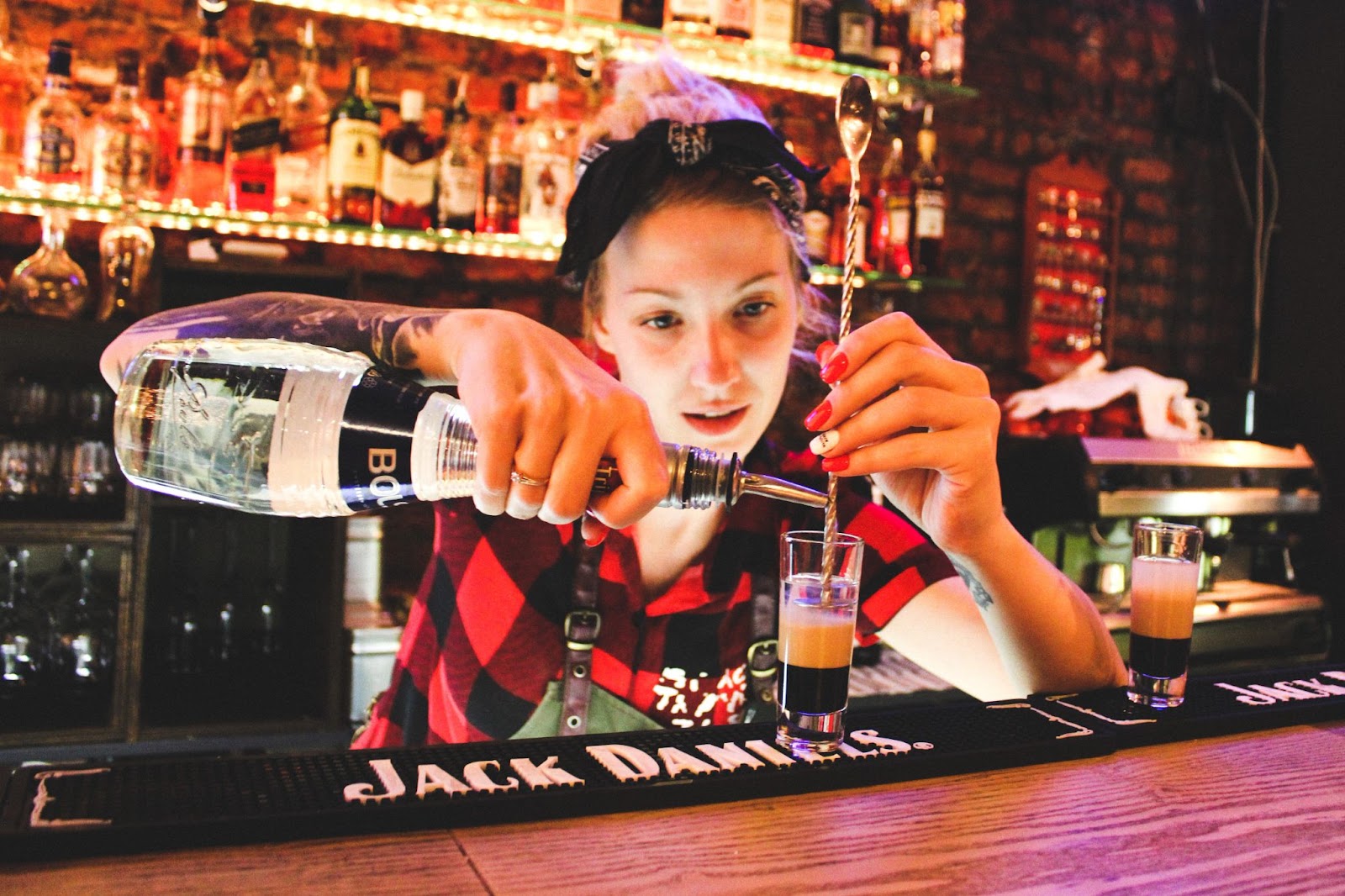
A bartender is essential to any drinking operation. Of course you need someone behind the bar slinging cocktails, stirring glasses, and pouring beers. But a role that is just as important in a bar is a barback. Someone who might not necessarily stand front and center in the eye of the customers, but rather scurries around washing glasses, refilling garnishes, stockpiling napkins, and pretty much doing all the other little tasks that make sure a bartender can perform their best.
Similar to bussers in restaurants, barbacks fill in behind the scenes, performing necessary duties that keep your establishment running smoothly everyday.
For that reason, barbacks are one of the most important pieces of a bar team.
If you’re becoming a new bar owner or looking to improve your current bar staff, hiring a knowledgeable, hard-working barback is key.
What We’ll Cover in This Piece:
What Exactly Is a Barback?

Photography courtesy of The Blackrabbit | Unsplash
The easiest way to describe a barback is by comparing them to a busser. In a restaurant, the busser is responsible for all those little nitty gritty details such as refilling water glasses, keeping the salt and pepper shakers filled, and getting food out to tables, along with many other menial things.
Similarly, a barback performs those equivalent duties in a bar. For example, a barback could do anything from keeping the lemon, lime, and orange wedges stocked and cleaning up spills to bringing up fresh kegs and polishing glasses.
A great barback has their eyes peeled and thinks twenty steps ahead, seeing what needs refilling, restocking, or replenishing and doing those assignments without being asked.
For this reason, a barback doesn’t necessarily have any skill requirements, but they do need a good work ethic, attitude, attention to detail, ability to adapt in a fast-paced environment, and capability to carry heavy items (such as kegs).
Oftentimes barbacks work their way up to bartenders, learning skills of the job on the fly by watching others.
What Are the Essential Duties of a Barback?

Photography courtesy of Daniel Herron | Unsplash
A barback’s duties can change by the minute, but to give a general overview, here’s what you should expect of and assign to your barback during and after service:
During Service
- Changing out empty beer kegs with fresh, full ones
- Restocking liquor bottles
- Keeping essentials topped off such as napkins, toothpicks, straws, etc.
- Refilling ice wells
- Cutting garnishes such as lemon, lime, and orange slices or fresh herbs as needed or filling olive and pickle jars
- Getting bartenders clean rags as needed
- Cleaning and polishing glasses
- Keeping counter spaces clean
- Sweeping up any spills or broken glass
- Helping punch in drink orders as needed
- Running trash and keeping the trash cans clear
- Running drinks and clearing tables with empty glasses
After Service
- Taking out the trash and recycling
- Breaking down the bar area
- Cleaning, cleaning, cleaning! This could include washing dishes and glasses, wiping down the counters, sweeping and mopping the floors, etc.
- Restocking the bar for the next shift with the appropriate bottles, kegs, and supplies
- Handling any liquor deliveries that need to be put away
Because all of these tasks could be considered physically demanding, there are some important considerations to keep in mind when hiring a barback.
What Should You Look for When Hiring a Barback?

Photography courtesy of Chino Rocha | Unsplash
Your first step before hiring any barback is to check your state’s on-premise alcohol serving laws. While the legal minimum drinking age in the U.S. is twenty-one, for many states you can actually start serving alcohol at the age of eighteen.
For example, in California, the minimum age to serve beer, wine, and spirits is eighteen, while in Arkansas it is nineteen, and in Alaska it is twenty-one. Going even further, some states have extra restrictions for those under twenty-one. For example, a supervisor might need to be present while someone underage is barbacking, or a minor might need to receive additional server training. Again, you must check your local state laws regarding underage serving before hiring any barback. Additionally, we highly recommend checking with your lawyer, so you can fully understand the policies and legal responsibilities in your area.
After squaring away the legalities of a barback, we’ve listed a few qualities you should look for in any potential hire.
As we mentioned, a barback doesn’t necessarily need any specific degrees or qualifications, but you should look for someone that has at least some or a mix of these traits:
- Works calmly and cleanly in a high-pressure environment
- Thinks on the fly and on their feet
- Calculates numbers in their head quickly
- Communicates well with others
- Stays organized in chaotic situations
- Carries large loads easily
- Maintains a positive attitude
- Keeps constantly moving and on the lookout for things that need to get done
- Desires to be a bartender one day
That last bullet point might be the most important.
According to our own guide to hiring in the hospitality industry, if someone has the desire to work in the bar, hospitality, or beer industry, seeing themself as a bartender or brewer in three to five years could be a good sign they’re more committed to the grind.
Still wondering how you can spot these qualities in a potential candidate? With any potential hospitality candidate, here are 11 essential questions to ask
How Much Should You Pay a Barback?

Photo by Stanislav Ivanitskiy on Unsplash
According to Glassdoor, the average amount a barback makes in the United States is $32,601 per year. But barbacking is normally an hourly position with tips added on at the end of the night. Traditionally, bartenders will give their barbacks anywhere from 1-3% of sales or 10-20% of tips according to this article from Binwise
For example, if a bartender garners $300 in tips a night, they might give their barback anywhere from $30 to $60
Of course, all this depends on the actual rules in your bar for tipping and tipping out. Every establishment handles tipping a little differently, so make sure that you have a firm tipping policy in place. And most importantly that your entire staff knows the rules and follows them.
How Can You Attract a Barback to Work at Your Bar?

Photography courtesy of Natasha T | Unsplash
Beyond respectable pay and a fair tipping policy, attracting potential barback candidates will come down to how you pitch your business.
In the job description you write, keep things super simple. People who work as barbacks most likely just want to know the basic details: What is the name of your bar? Where is it? What is the expected hourly wage? What are the day-to-day duties? And most importantly, what is your bar all about?
Are you an Irish pub that serves mostly twenty-two-year-old fresh-out-of-college graduates? Are you a sports bar dedicated to one team? Are you more of a craft beer bar? That last little detail can be essential to attracting the right person to work for your team. Someone who is passionate about your bar identity will be more likely to become a loyal employee, working their way up from barback to bartender to even more one day.
Three Tips for Training Your Barback
You’ve found the perfect candidate and asked them to join your team, now what? You need to prepare a new barback for success. Here are three tips we have for making sure your barback maximizes their training:
Give Them a Chance to Shadow
The best way to learn is by doing. A simple but true mantra. To start, take your barback on a tour of your entire establishment and get them familiar with all the different areas. From there, have them shadow another barback or simply watch a bartender during a shift, pointing out all the areas and duties that need to be covered. Have them spend time directly with your bartenders so they can learn their needs along with any tricks or tips to make service run more smoothly.
Pave Their Career Path

Photography courtesy of Louise Hansel | Unsplash
Chances are if you hired the right barback they’re interested in the hospitality industry and potentially working their way up to bartender one day. Encourage them to get to know your bartenders and learn from them. Those whom you groom in your organization will be more likely to stick around and grow with your team. A loyal team member tends to give better service, which reflects better on you and your establishment. It’s a win-win for everyone.
Learn the Menu Like a Playbook
All of your cocktails, beers, wines, spirits, drinks, and food are like the playbook for your bar. Your barback should be fluent in this language. Make them study the menu over and over again until they know it back to front. Chances are they’ll be called upon to enter orders, describe items to customers, and create garnishes or restock items needed for everything on your menu. It is crucial that your barback understands and becomes well versed in your menu.
Other Content You May Enjoy
To succeed and grow your restaurant, bar, or brewery you need to stand out in local search results. Whether someone is searching for the “best craft beer near me” or “top-rated seafood restaurant in [your city],” Local SEO (Search Engine Optimization) helps your business appear at the top of those search results.
With 81% of consumers using Google Search and Maps to find local businesses, and nearly 90% of customers choosing a business on the first page of search results, optimizing your online presence is essential.
This guide will walk you through Local SEO strategies tailored for restaurants, bars, and breweries, covering Google My Business, website optimization, online reviews, local backlinks, and more.
By the end of this guide, you’ll have a step-by-step action plan to increase your search rankings, attract more local customers, and grow your business.
In today’s digital world, having a well-designed, functional website is essential for restaurants, bars, and breweries. It goes beyond having social media. A great website can help attract new customers, showcase menus, accept reservations, and even drive online sales. But one of the most common questions business owners ask is: How much should a website cost in 2025?
The answer depends on several factors, including the type of website, features, complexity, and whether you choose a DIY solution or hire a professional web developer. Costs can range from a few hundred dollars for a basic website to tens of thousands for a fully customized, feature-rich platform.
This guide will break down website costs for restaurants, bars, and breweries, helping you understand the pricing landscape and choose the best solution for your business
Trivia nights have become an incredible marketing strategy for bars, restaurants, and breweries to draw in crowds and engage with new customers. With the recent collaboration between Geeks Who Drink, Timeplay, and the iconic television show Jeopardy!, businesses now have an exciting opportunity to host the Jeopardy! Bar League. This partnership combines the global brand recognition of Jeopardy! with Timeplay’s cutting-edge technology and the fun of live trivia from the experts at Geeks Who Drink.
In this piece we’ll cover what this new collaboration between these two trivia powerhouses is and how you can bring this unique experience to your venue.
In today’s world, both websites and social media platforms are crucial for a brewery, bar, or restaurant’s online presence. However, consumer habits show distinct preferences for each, depending on the context of their search or interaction.
In this guide, we’ll go over the basics, walk you through how to leverage these tools effectively, and show you how understanding these trends can help your venue better meet your customers’ expectations.
As a restaurant, bar, brewery, or any venue with a food and beverage program, having a modern, functional, and aesthetically pleasing website isn’t just a luxury—it’s a necessity.
No matter the size of your business, your new potential customers often interact with your website first—and first impressions matter.
In this piece, we’ll explore the top website trends shaping the online presence of hospitality businesses in 2025. These trends will help your venue stand out and attract more customers while creating a unique and modern experience to establish the perfect guest experience from start to finish.
For bar owners, hospitality managers, and small business owners, selecting the right gin brands is more than just filling the shelves—it’s about curating a distinctive customer experience. Gin has soared in popularity, becoming a staple of modern cocktail culture. With its complex botanical infusions, gin offers versatile, memorable flavors that can attract a wide range of customers. But with so many choices available, which brands should you prioritize to bring out the best in your gin menu?
This guide explores the seven best gin brands that have proven themselves through quality, craftsmanship, and unique flavor profiles. By understanding what makes each brand special, you and your staff will be better equipped to create a standout gin selection that delights your patrons, reinforces your brand’s reputation with a robust gin drinks menu, and helps you continue crafting classic and innovative gin cocktails.

